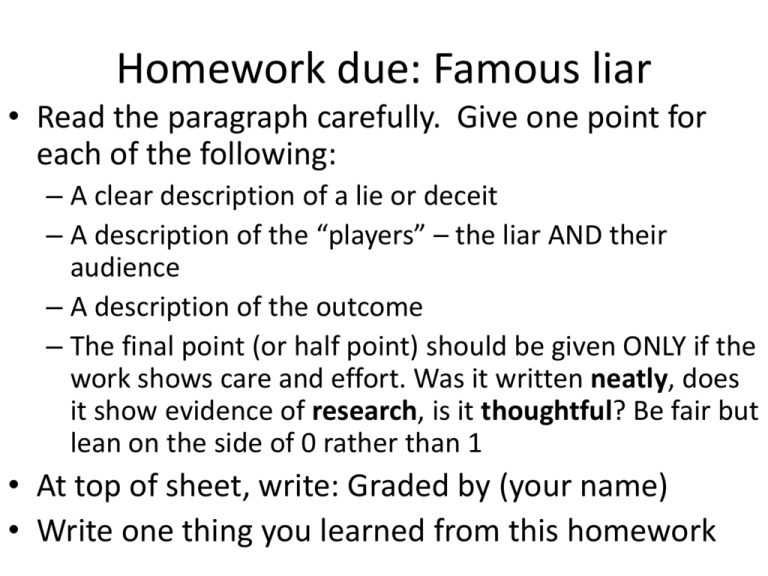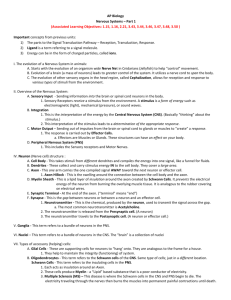File
advertisement

Homework due: Famous liar • Read the paragraph carefully. Give one point for each of the following: – A clear description of a lie or deceit – A description of the “players” – the liar AND their audience – A description of the outcome – The final point (or half point) should be given ONLY if the work shows care and effort. Was it written neatly, does it show evidence of research, is it thoughtful? Be fair but lean on the side of 0 rather than 1 • At top of sheet, write: Graded by (your name) • Write one thing you learned from this homework Biological Psychology The biological structures and chemicals which create our conscious experience PLEASE DON’T DRAW OR WRITE ON THE IMAGES Write in your notes Using the images, generate possible answers to the following questions Discuss as a group, then each describe in writing what you think is going on in the top image, labelled A. • How is this system physically organized? • What is this system’s function? • How does it work? IF YOU DON’T KNOW: GUESS, IMAGINE, MAKE SOMETHING UP! Keywords for image A • Now reword your answers to image A by adding as many of these words into your descriptions as you can • Brain • Neuron (brain cells) • Signal • Send • Receive • External stimulus • Response • Central nervous system • Peripheral nervous system • The nervous system is composed of neurons (brain cells) distributed throughout the body. The brain is the main processing center that makes decisions and commands the body. It sends signals out and receives information collected by the body. • The CNS is made of the brain and spinal cord, the PNS is composed of nerves going out from the spine all over the body and back. Nervous System Central Nervous System (CNS) Peripheral Nervous System (PNS) Neurons are the elementary components of our nervous system, which is our body’s speedy electrochemical information network. 7 The Nervous System • The brain and spinal cord form the central nervous system (CNS). 8 • The peripheral nervous system (PNS) links the central nervous system with the body’s sense receptors, muscles, and glands. 9 • Ratio of brain to body weight provides a clue to a species’ intelligence. • Dinosaurs = 1 / 100,000th 10 Whales = 1/ th 10,000 11 Elephants = th 1/ 600 12 Humans = 1/ th 45 13 Mice = 1/ 40th 14 Nervous System Central NS (CNS) Peripheral NS (PNS) Brain: Spinal Cord: Control center for entire NS Connects brain and PNS, and enables reflexes Somatic NS: Autonomic NS: Senses CNS Involuntary, controls organs and glands CNS Muscles Sympathetic NS: Parasympathetic NS: “Fight-or-flight” system “Rest-and-digest” system Controls body when aroused Controls the body during normal rest state Using the images, generate possible answers to the following questions Discuss as a group, then each describe in writing what you think is going on in the second image, labelled B. • Describe the parts of this cell. • Where are these cells located? What do they comprise (build)? • What is this cell’s function? • How does it work? IF YOU DON’T KNOW: GUESS, IMAGINE, MAKE SOMETHING UP! Keywords for image B Draw and label a neuron. Now reword your answers to image B by adding as many of these words into your descriptions as you can. • Dendrites • Cell body (soma) • Axon • Terminal buttons • Neurotransmitters • Synapse (gap) • Electrical signal • Chemical signal Using the images, generate possible answers to the following questions Discuss as a group, then each describe in writing what you think is going on in the third image, labelled C. • Where is this on a neuron? • What’s happening? • What is a possible result, what happens next? IF YOU DON’T KNOW: GUESS, IMAGINE, MAKE SOMETHING UP! Keywords for image C Draw and label a synapse. Now reword your answers to image C by adding as many of these words into your descriptions as you can. • Terminal buttons • Neurotransmitters • Action potential (signal down axon) • Release • Receptors • Excitatory signal • Inhibitory signal • Synapse Using the images, generate possible answers to the following questions Discuss as a group, then each describe in writing what you think is going on in the third image, labelled D. • What does this diagram represent? • What is the external stimulus? • What are the brain and body’s responses? IF YOU DON’T KNOW: GUESS, IMAGINE, MAKE SOMETHING UP! Keywords for image D . Now reword your answers to image C by adding as many of these words into your descriptions as you can. • External stimulus • Sensory organs • Neural pathways • Memory • Cognition (thinking, processing) • Response (please specify) Time: Note check • HOM Quality grade Neuron Questions • What is a neuron and what is its function? • Describe the main parts of a neuron and their roles. • What is an action potential? • What does this mean: “an action potential is an all or nothing event”? • Explain why neural communication is both electrical and chemical. • What chemicals are involved in neural communication? Today we’ll learn • The structure and function of neurons (brain cells) • How they work at the molecular level (their chemistry) • The forces that drive them (their physics) Homework • Complete the neuron worksheet • Due tomorrow (Friday) • Start now: Answer questions 1 & 2 Neuron: The cell of the nervous system. Dendrites, Cell body (or soma), Axon, Myelin sheath, Nodes of Ranvier, Terminal buttons, Synapses Neurons and Glia • There are many different types of neurons – different shapes do different jobs – Neurons transmit signals • Glial cells are support cells – Help neurons function – clean, organize, support – Astrocytes – star-shaped. clean, structure, eat dead neurons. – Oligodendrocytes - Oligodendrocytes are cells that wrap tightly around axons to form the myelin sheath. Signal transmits 30X faster If the brain was a school… • Neurons would be teachers (workers who perform main function of school) • Glial cells would be ____________ (workers who support teachers and keep school running smoothly) Use your grey matter! • Some neurons have naked axons. They appear grey. • Other neurons are covered in myelin sheath (made of oligodendrocytes). They appear white. • Myelinated neurons transmit signals faster! • So using your grey matter is a silly. Better to use your white matter! Neural signaling pathway 1. Dendrites receive neurotransmitters (chemical signals) from other neurons a) Signals are + or – (excitatory or inhibitory) b) Signals affect the voltage of the neuron’s membrane 2. The cell body sums up the + and – signals a) If there’s enough excitation, the cell “fires” b) Called an action potential c) The membrane potential must be -55 mv for it to fire 3. When the neuron “fires” it sends an electrical signal down its axon a) This is generated by Na+ ions entering the cell along the axon, increasing the membrane potential 4. At the axon terminal, neurotransmitters are released across the synapse a) They attach to receptors on the next neuron’s dendrites b) They may be + or - What happens when a neurotransmitter attaches to a receptor? http://www.youtube.com/watch?v=A1sdk7hy Gz8 • Answer: when neurotransmitters bind to receptors, the receptor opens and allows ions into the cell • If positive ions (ex NA+) cell membrane voltage increases • If negative ions (ex Cl-) cell membrane voltage decreases How does a cell decide to have an action potential? • Cell body sums all the excitatory and inhibitory neurotransmitters on its dendrites • Cell membrane at rest has potential energy of -70 mv • If stimulated to -55 mv, it fires (action potential) Action potential in detail • http://bcs.whfreeman.com/thelifewire/conten t/chp44/4402002.html • College only – resting potential http://bcs.whfreeman.com/thelifewire/content/ chp44/4402001.html Hw: You’re making the next test! • Email me 2 multiple choice questions that YOU create • Question and 4 answer choices. Hard please! • DO NOT FORMAT (NO BULLETS/NUMBERING) • Email me: cprentoulis@davincischools.org • Good topics: – NTM, action potential, neuron anatomy, agonists/antagonists, myelin sheath, glial cells, membrane voltage (mv)









